Missions to Mercury
In the early 1970s, Mercury was a world of mystery. Hindered by the planet's small size and proximity to the Sun, Earthbound astronomers could only sketch vague dark markings on their maps of Mercury and speculate over what they really meant.
Meanwhile, ground-based and balloon observations at optical, radar and infrared wavelengths found no evidence of an atmosphere. This suggested that Mercury's Sun-baked surface would preserve a record of the earliest events in the history of the Solar System, free from the erosive action of wind, water or ice.
To Mercury via Venus
The only way to turn the speculation into hard fact was to dispatch a spacecraft to the enigmatic little world. However, this was not quite as easy as it sounded.
Although Mercury sometimes closes to a distance of about 77 million km from Earth, a lot of energy is required to brake a spacecraft into a transfer orbit which intersects that of the innermost planet.
The most energy efficient method to reach Mercury is to take advantage of the gravitational pull of Venus. Studies conducted in the 1950s and 60s showed that such gravity assists could be used to alter a spacecraft's trajectory without the use of rocket propulsion.
In October 1962, UCLA graduate student Michael Minovich came to the conclusion that such Venus swingby opportunities would be available in 1970 and 1973.
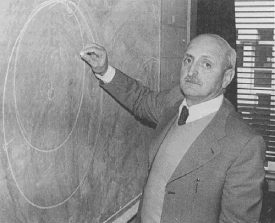 |
| Giuseppe Colombo. Credit: ESA |
As NASA began to study a Mariner-Venus-Mercury mission, Giuseppe (Bepi) Colombo, a distinguished Italian specialist in celestial mechanics who taught at Galileo's old university in Padua, put forward a proposal that had the potential to triple the scientific return from such a mission.
Colombo had previously revolutionised studies of the innermost planet by proposing that Mercury rotated once every 59 Earth days, rather than the widely believed figure of 88 days.
His studies of the planned Mercury mission recognised that, after the first flyby, the spacecraft would enter a 176 day orbit around the Sun. This was exactly double the 88 days that it takes Mercury to complete one revolution around the Sun – Mercury's year. With a few minor orbital corrections, the craft could repeatedly return to Mercury's orbit at precisely the times when the planet was in that location. The only drawback was that the surface lighting conditions would be the same for each encounter.
Mariner 10
The Mariner-Venus-Mercury mission, eventually renamed Mariner 10, lifted off from Cape Canaveral, Florida, on 3 November 1973. It was the first mission to visit two planets and also the first spacecraft to use the gravitational attraction of one planet to reach another.
The historic gravity assist by Venus took place on 5 February 1974 when Mariner 10 swept past at a distance of 5768 km. This close encounter modified the spacecraft's trajectory and speed, putting it on course for an encounter with Mercury.
In the first fuzzy images returned on 24 March 1974 from a distance of 5.4 million km, Mercury appeared as a broad crescent. As the range closed, it became clear that the planet did, indeed, have an intensely cratered surface that closely resembled the ancient lunar highlands.
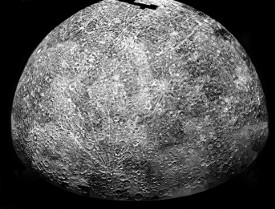 |
| Image of Mercury taken with Mariner 10. Credit: NASA/JPL |
Although the closest approach on 29 March 1974, at a distance of 703 km, took place on the planet's night side, Mariner 10 was able to send back images of a different sunlit hemisphere on the outward leg.
To scientists' surprise, the plasma and particle data indicated the presence of a substantial magnetic dipole field similar to that of Earth. According to theory, such a magnetic field is created by an internal dynamo located within a fluid inner core.
In the case of Mercury, the planet is so small that the liquid iron core was expected to have cooled and solidified billions of years ago
In accordance with Bepi Colombo's pre-launch calculations, the spacecraft was able to make repeated flybys above the same hemisphere of Mercury with only minimal use of its propulsion system.
The second encounter on 21 September 1974 followed a trajectory that enabled the spacecraft to image the southern hemisphere. In order to image the entire hemisphere, thereby linking the two regions seen during the first encounter, the second flyby took place on the sunlit side at an altitude of 48 069 km. Although the spatial resolution was a modest 1-3 km, the 360 images increased the coverage of the illuminated hemisphere from about 50% to 75%.
The third flyby, on 16 March 1975, primarily concentrated on magnetic and particle measurements in an effort to improve understanding of the planet's magnetosphere and its interaction with the solar wind.
During this final encounter, Mariner 10 swept over the surface at a height of only 327 km. Some stunning close-up images were received, although a problem with the ground station in Canberra, Australia, meant that only one quarter of each high resolution picture could be received.
Mariner 10 was shut down on 24 March 1975 after its onboard fuel supply was depleted. Altogether, more than 2300 black and white images of Mercury were taken, many at moderate resolution (3-20 km/pixel) but a limited number with a resolution of only 140 m. Altogether, 45% of the planet was imaged.
The surface was seen to be subdivided into intercrater plains, smooth plains, and heavily cratered terrain that resembled the landscapes on Earth's Moon. The most notable individual feature, partially visible on the sunrise terminator, was a giant impact basin that was named Caloris.
Other surprising features were steep cliffs, hundreds of kilometres in length, that appeared to have been formed by global compression, possibly due to shrinkage of the planet as it cooled.
Ultraviolet observations by Mariner 10 revealed that there is a very thin atmosphere. (The proper term is exosphere, since the few gaseous atoms on Mercury rarely collide. In an atmosphere, the gaseous atoms are in constant collision.) The surface pressure is a fraction of a pico-bar, or about one trillionth (1/1 000 000 000 000) the sea level air pressure on Earth.
MESSENGER
For three decades, Mariner 10 remained the only spacecraft to visit Mercury, and almost all of our knowledge about the planet was based on the brief observations made during its three flybys in 1974-75.
Despite this initial reconnaissance, Mercury remained a mystery. Less than half of its surface had been imaged and scientists knew less about Mercury than any of the other planets.
In order to complete the survey of its cratered surface and make the first in-depth examination of this small world, NASA decided to develop the MESSENGER (MErcury Surface, Space ENvironment, GEochemistry, and Ranging) mission.
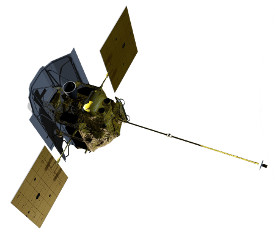 |
| Artist's impression of the MESSENGER spacecraft. Credit: NASA/Johns Hopkins University Applied Physics Laboratory/Carnegie Institution of Washington |
MESSENGER was launched on 3 August 2004 and entered a near-polar orbit on 18 March 2011 (GMT). During a 7.9 billion km journey that included 15 circuits of the Sun, MESSENGER received gravity assists from Earth, Venus and Mercury itself before entering orbit around the planet. Mercury flybys in January 2008, October 2008 and September 2009 enabled the spacecraft to match the planet's speed prior to the orbit insertion manoeuvre. During these encounters, the spacecraft mapped almost the entire planet and gathered data critical to planning the nominal year-long orbit phase (equivalent to four Mercury years, or two Mercury solar days).
During the primary science mission, MESSENGER operated in a highly elliptical, near-polar orbit around Mercury, flying 200 km above the surface at the closest point (periapse) and 15 193 km at the farthest (apoapse). The plane of the orbit was inclined 82.5° to Mercury's equator, and the low point in the orbit occurred above 60°N. MESSENGER orbited Mercury twice every 24 hours; for one third of this period it was oriented to send data to Earth.
MESSENGER carried seven instruments to examine the planet's surface, atmosphere and near-space environment. The multispectral imaging system enabled scientists to image nearly all of the planet in stereo in order to determine topographic variations and landforms.
Its X-ray, gamma-ray, and visible-infrared spectrometers determined the elemental and mineral composition of the rocks on the surface. The neutron spectrometer was used to estimate the amount of hydrogen – evidence of water ice inside polar craters.
A laser altimeter mapped Mercury's landforms and surface topography. The altimeter data and careful tracking of MESSENGER's trajectory, helped to determine the thickness and structure of the crust and map the planet's gravitational field. Other instruments studied the magnetic field and the composition of Mercury's tenuous atmosphere.
MESSENGER's mission was extended until it ran out of propellant and plummeted into the planet on 30 April 2015. By that time, it was clear that huge areas of the planet have been resurfaced by volcanic activity. The most prominent feature was an extensive area of volcanic plains at high northern latitudes.
The 1500 km wide Caloris Basin was found to be filled with smooth plains material that appears to be very similar to the mare basalt flows on the Moon. MESSENGER also discovered shallow, irregular depressions, called 'hollows', that appear to be unique to Mercury.
There were some other surprises. Mercury's magnetic field was found to be offset northward along the planetary spin axis by 484 km, about 20% of the planet's radius. The internal magnetic field is 100 times weaker than that of Earth, so it provides very little protection from the solar wind.
MESSENGER also provided strong evidence that water ice has survived in Mercury's polar regions. Radar bright deposits located in cold craters filled with permanent shadow coincided with decreased neutron flux at higher latitudes - evidence for the presence of hydrogen derived from water ice.
Despite its high density and presumed iron core, Mercury was found to have low amounts of iron on its surface, but quite high abundances of volatile elements, including sulphur, sodium and chlorine.
BepiColombo
Since 2000, ESA and Japan have been working on an ambitious, dual spacecraft mission to explore Mercury. The mission is named in honour of Giuseppe "Bepi" Colombo (see above).
BepiColombo comprises a carrier spacecraft, known as the Mercury Transfer Module (MTM), and two separate orbiters. ESA built the Mercury Planetary Orbiter (MPO), while the Japanese space agency, JAXA, contributed the Mercury Magnetospheric Orbiter (also referred to as Mio). Once they enter orbit around the planet, they will carry out the most comprehensive exploration of Mercury and its environment ever undertaken.
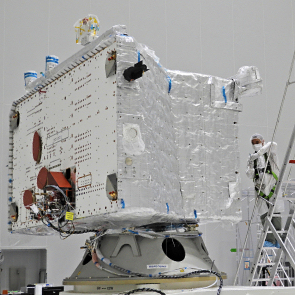 |
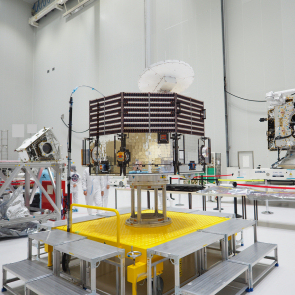 |
| BepiColombo Mercury Planetary Orbiter. Credit: ESA–B.Guillaume |
BepiColombo Mercury Magnetospheric Orbiter. Credit: ESA/JAXA–G.Murakami |
Launched on 20 October 2018, BepiColombo is on a seven-year journey to reach Mercury. The carrier spacecraft is driven by a highly efficient, low thrust, electric propulsion system that steadily propels it along a series of arcs around the Sun. The trajectory will also be modified by nine planetary flybys.
BepiColombo will return to Earth's vicinity in April 2020, fly past Venus in 2020 and 2021, and then receive six gravity assists from Mercury itself between 2021 and 2025.
Once the spacecraft's speed has been slowed sufficiently by these manoeuvres, the MTM will be jettisoned and BepiColombo will be captured by Mercury's gravity in December 2025.
The MPO will then fire its chemical propulsion thrusters to lower the orbit before the European and Japanese craft are deployed in separate orbits to begin their different missions. The two orbiters will explore Mercury for one Earth year (equivalent to four Mercury years), with the option of a one-year extension.
Flying in a 480 km × 1500 km polar orbit, the MPO's 11 instruments will concentrate on the planet's surface and internal composition. The payload consists of two cameras for high-resolution imaging and a suite of spectrometers designed to reveal the surface composition, search for water ice, and analyse Mercury's exosphere.
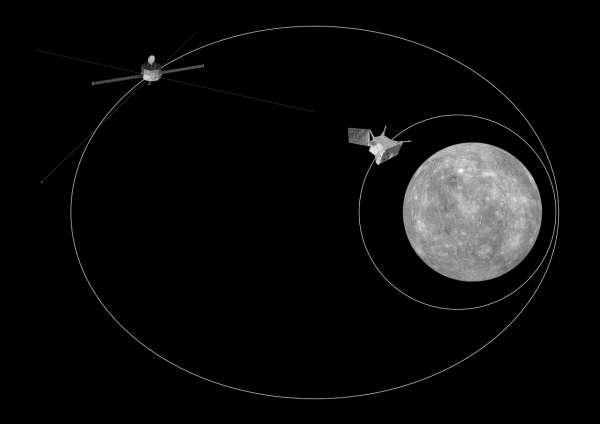 |
| BepiColombo spacecraft in orbit around Mercury. Credit: ESA/ATG medialab |
A laser altimeter will measure the surface morphology, while data from the dual band radio science experiment and an accelerometer will measure the gravity field with great accuracy in order to better estimate the distribution of mass within the planet and to study relativistic effects.
The smaller, octagonal Mio will observe the planet's magnetic field and its interactions with the solar wind from a highly elliptical, 590 × 11 640 km polar orbit. As it spins 15 times per minute, four wire antennas (each 15 m in length) will be used to make electric field and radio wave measurements, with two 5 m masts for magnetic field measurements.
By the end of the BepiColombo mission, scientists will not only have an-depth understanding of the little iron world, but also have a mass of data that will help them to unravel how Earth and its planetary neighbours formed some 4.5 billion years ago.




